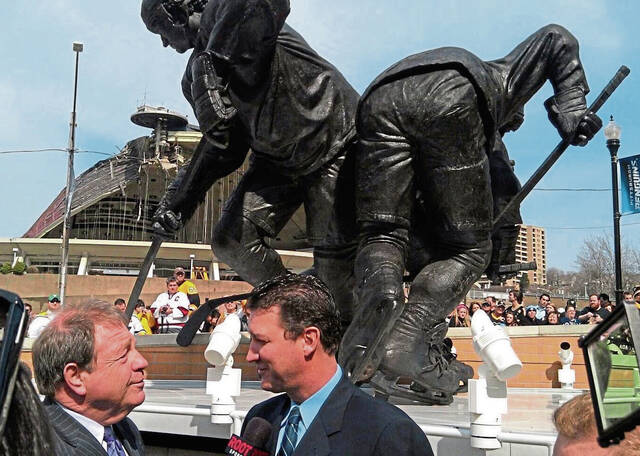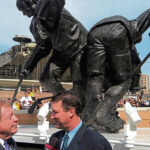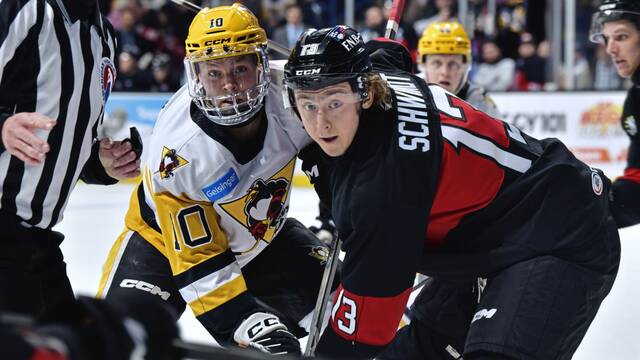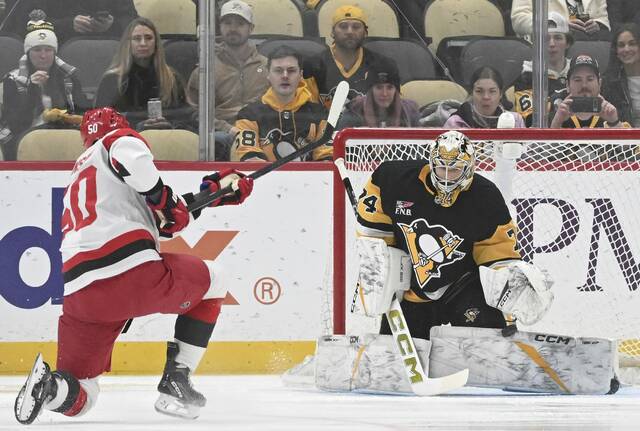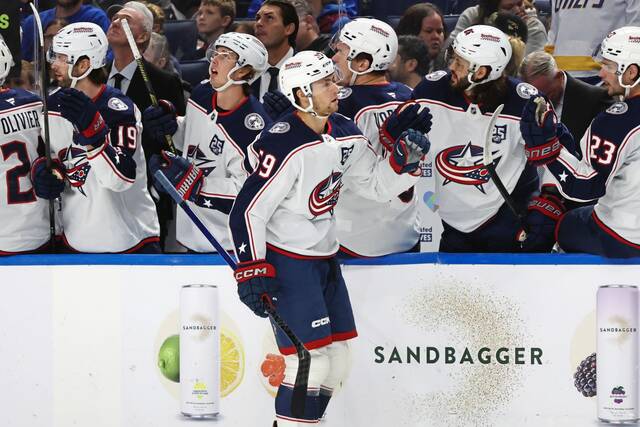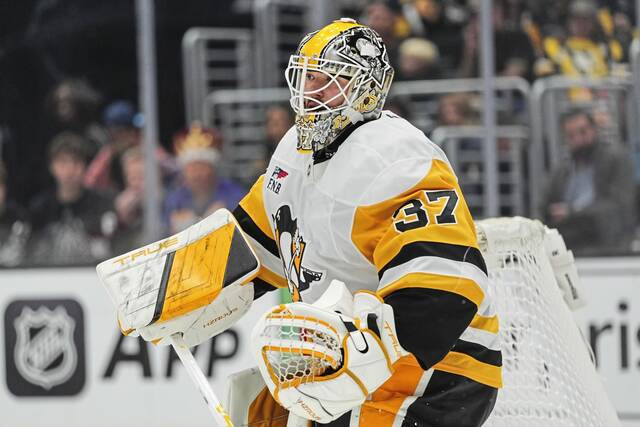Stan Savran was an experienced interviewer.
He had talked to the titans of sport ranging from Muhammad Ali to Arnold Palmer.
So talking to Mario Lemieux was nothing out of the ordinary for Savran.
But the circumstances were simply spectacular.
In the late fall and early winter of 2000, Lemieux, arguably the most brilliant talent in hockey history, was working out in an intense but quiet — covert, really — fashion on Neville Island at Robert Morris Island Sports Center Ice Arena with former teammate Jay Caufield in hopes of a comeback to the sport after retiring three-plus years earlier.
Savran was tipped off to the early-morning sessions and made his way to the facility in the middle of the Ohio River.
A veteran of nearly 25 years in covering Pittsburgh sports at that point his career, Savran had built up enough capital with subjects to earn respect and, most importantly, trust with those he covered.
As a result, the first interview Lemieux and Caufield granted about the ambitious endeavor was to Savran.
“He said it was one of his best moments in sports with Mario coming back to the game,” Caufield said by phone Tuesday. “But it wasn’t sappy. It was just straightforward. It was very, very comfortable at that moment. We were still on the fence of where this was going. But I think Mario was getting to the point of getting comfortable enough with it.
“And Stan was the perfect one to communicate with.”
Savran, who died at the age of 76 on Monday after bouts with cancer and diabetes, was the perfect one to discuss just about any sport or any of Pittsburgh’s teams in any context.
But his connection to the Penguins was perhaps so much more direct than with the city’s other clubs.
Going back to when Savran came to Pittsburgh from Cleveland in 1976, he was one of the first sports talk radio hosts who regularly discussed the mundane Penguins when they were largely dwarfed by the Super Bowl champion Steelers, the World Series contending Pirates and even Pitt football, then a national power.
Savran even served as an occasional studio host for local broadcasts when the games were carried on WPGH television.
“As a college-aged fan when Stan first came to Pittsburgh, he was the first guy in Pittsburgh media who you could listen to and talk about hockey,” said Tom McMillan, formerly the Penguins vice president of communications as well as a beat writer for the team throughout the 1980s and 1990s. “The Penguins, obviously, weren’t big in the 1970s. There wasn’t any hockey talk. It just didn’t exist. Stan was the first guy who talked about it. He didn’t really know much about it — he was learning about it along the way — but he took it seriously. He was the first oasis, kind of, for hockey fans well before the Penguins were big in town and well before Mario.
“He thought it was important. He learned about it.”
Joining WTAE television in 1981 while also doing a one-hour talk show on WTAE-AM, Savran made it a point to be a regular presence at morning skates and games at a time when relatively few reporters did so.
“The one thing that I can guarantee you’ll hear from everybody, every player — at least in our locker room — was that we all liked Stan,” said former Penguins forward Phil Bourque, today a radio broadcaster with the team. “Never a bad word about Stan. That kind of led you to trust him because you liked him and you saw the way he went about his business.
“There was a consistency to his personality, just him as a person, or the consistency to the way he went about his business. If he came over to talk to you, whether it was off the record or on the record, you knew that you trusted him. Things that you told him, there was a filter there.”
After being fired by WTAE television in 1991, his connection with the Penguins, as well as the Pirates and Steelers, led to Savran joining the former KBL cable station — today known as AT&T SportsNet — and launching “SportsBeat,” a sports talk show on television, a novel idea in that era.
“ ‘SportsBeat,’ that’s where he really excelled and made a big name for himself,” said former Penguins play-by-play broadcaster Mike Lange. “(Savran and Guy Junker), they just seemed to have great chemistry. They did a lot of work. That was all live stuff. It was a lot of pre-work to get it ready.
“He would be at the morning skates and he would do his interviews. Sometimes, really long ones that would drive the guys crazy. But he needed that programming for his show. That’s where he really (stood) out. It was really the first of its kind in America to have a live show about sports. It was really special. ESPN was on at that time, but, locally, when he did it, it was pretty special. It kind of grew over the years.”
In many ways, “SportsBeat” became the source in Pittsburgh for all things hockey, not just with the Penguins, but NHL-wide. After all, this was largely a pre-internet world where infinite information wasn’t readily available through a computer or phone.
“It was a staple,” Bourque said. “You watched the six o’clock news, and then at 6:30, you flipped over to KBL because ‘SportsBeat’ was on. Either he had the latest on the Steelers or other stuff going on around sports. … Whether it was a big interview or talking about something else going on in the league. There was no place else to get your sports or your hockey info. It was just on. … It was always on in the background.”
“SportsBeat” eventually became something of a template for presenting Penguins broadcasts on KBL and its succeeding iteration, Fox Sports Pittsburgh. At the time, not many local television outlets offered such a luxury for hockey, at least in the United States.
“It was such a powerful, iconic show,” McMillan said. “He and Guy would do pregame shows and postgame hockey hotlines. Their shows would turn into Penguins shows. As soon as the game ended, Stan and Guy were talking about it. Part of that was then how the players then knew him because they would watch. Stan could come into the room and everybody knew who he was.”
Savran’s authority on the sport allowed him to serve as color commentator alongside Lange for a significant portion of the 1993-94 season. That led to an unfortunate mishap in Hartford, Conn.
“He worked with me, and we had a lot of fun,” Lange said. “I got a chance to be in the booth with him. We were in Hartford one night (at the former Hartford Civic Center). … It was the original ‘nine-mile hike’ broadcast booth in the rafters. They just put two chairs there. So it was ridiculous, really, where it was. Pretty low clearance when you walked in there. Well Stan, being the big man that he is, ‘BANG! BOING!’ Right off the noggin. Never forgot that. It got him pretty good.
“He did a pretty good job. He was thorough in what he was trying to prep for. We got along pretty well. I was happy to have him there. It was probably a good feel for him too. He earned a chance to do some games.”
Above all else, Savran garnered respect from so many with the franchise over the decades, including the most important figure in the history of the franchise.
“Obviously, it’s easy to respect Mario,” Bourque said. “But it’s not that easy to get Mario’s respect. Once you have it, you hang onto it forever. It’s so unique and so special and so exclusive. That’s why when Stan was around the (Robert Morris) rink when he was training with Jay, I don’t think anybody would have ever said, ‘Hey Savran, beat it!’ He was accepted.”
When Savran did speak with Lemieux and Caufield in December 2000, Lemieux’s comeback was still in something of an exploratory phase. That is to say Lemieux was still trying to ramp things up and see if he could still be the dazzling, dominant force he once was.
Lemieux’s comfort with Savran — he also granted Savran a live one-on-one television interview immediately after his final game leading into his first retirement in April 1997 — led to the two talking on the record before his comeback.
“Mario is very close to the vest,” Caufield said. “He was comfortable with me talking to Stan about what was going on. That speaks volumes. I don’t know what more to add than that point. ‘Let’s talk to him.’ ”
That pattern was maintained in August 2005 when the franchise’s next savior, Sidney Crosby, arrived and did his first local television interview with “Savran on SportsBeat.”
“From the Penguins’ standpoint, that’s what you did,” McMillan said. “When somebody came to town, a big player — nobody was bigger than Sid — you put them on “SportsBeat” with Stan. There was respect there.”
“You couldn’t do an interview with every media person in town. But you were doing one with Stan.”
“SportsBeat” was canceled in July 2009. Despite its success, national corporate interests without much insight (or consideration) to the Pittsburgh market opted to pull the plug. Regardless, Savran remained a fixture on Fox Sports Pittsburgh and its successive identities, Root Sports Pittsburgh and AT&T SportsNet Pittsburgh, until his death.
He and Caufield were “teammates” through much of that and worked on the station’s ancillary presentations related to the game broadcasts.
“What he was great with was follow-up questions,” said Caufield, who serves as an analyst. “If we need to fill another topic, his knowledge of all sports and his love for the game made it easy to come up with something. It was always entertaining. It was always good. I felt he was always prepared, always ready to go, always looking forward to covering that game on that specific game when he was working.
“A true love and passion for Pittsburgh, the city and the sports teams.”




